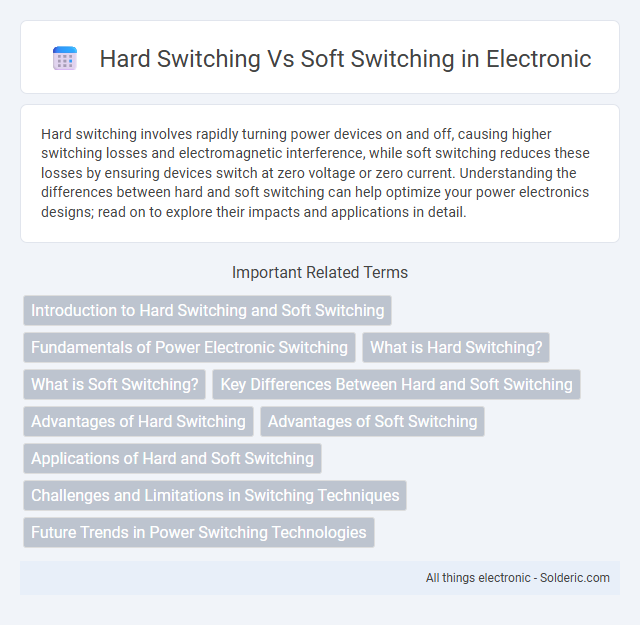Hard switching involves rapidly turning power devices on and off, causing higher switching losses and electromagnetic interference, while soft switching reduces these losses by ensuring devices switch at zero voltage or zero current. Understanding the differences between hard and soft switching can help optimize your power electronics designs; read on to explore their impacts and applications in detail.
Comparison Table
| Feature | Hard Switching | Soft Switching |
|---|---|---|
| Definition | Switching with abrupt voltage and current transitions. | Switching with controlled zero voltage or zero current transitions. |
| Switching Loss | High losses due to overlapping voltage and current. | Low losses due to minimized overlap during switching. |
| Electromagnetic Interference (EMI) | High EMI caused by sudden transitions. | Reduced EMI thanks to smooth switching waveforms. |
| Switching Frequency | Limited frequency to avoid excessive loss and stress. | Higher frequency achievable with lower losses. |
| Thermal Stress | Higher thermal stress on components. | Lower thermal stress, enhancing component lifespan. |
| Complexity | Simple circuit design and control. | More complex circuit and control strategies required. |
| Applications | Used in low-frequency, cost-sensitive applications. | Preferred in high-frequency, high-efficiency applications. |
Introduction to Hard Switching and Soft Switching
Hard switching involves turning power devices on and off abruptly, leading to higher switching losses, electromagnetic interference, and device stress. Soft switching techniques use zero-voltage or zero-current switching to minimize these losses and reduce stress, improving efficiency and reliability. Your choice between hard and soft switching depends on specific performance requirements, such as switching frequency and thermal constraints.
Fundamentals of Power Electronic Switching
Power electronic switching involves controlling the flow of electrical power using semiconductor devices, where hard switching forces the device to switch while voltage and current overlap, causing higher switching losses and electromagnetic interference. Soft switching techniques minimize these losses by enabling switching at zero voltage or zero current conditions, improving efficiency and reducing stress on components. Understanding these fundamentals helps you design circuits that optimize performance and reliability in power conversion systems.
What is Hard Switching?
Hard switching is a power electronics technique where the transistor switches between on and off states under full voltage and current conditions, causing high switching losses and electromagnetic interference (EMI). This method subjects components to significant stress due to rapid voltage and current transitions, impacting efficiency and thermal management. Hard switching is commonly found in traditional converter designs where simplicity is prioritized over performance optimization.
What is Soft Switching?
Soft switching is a technique used in power electronics to minimize switching losses and electromagnetic interference by ensuring that the power transistor switches on or off under zero voltage or zero current conditions. This method reduces stress on components, improves efficiency, and extends the lifespan of power converters compared to hard switching, where devices switch abruptly under high voltage and current. Understanding soft switching can help you design more efficient and reliable power systems.
Key Differences Between Hard and Soft Switching
Hard switching involves abrupt transitions of voltage and current, causing significant switching losses, electromagnetic interference (EMI), and stress on power devices. Soft switching employs techniques like zero-voltage switching (ZVS) and zero-current switching (ZCS) to minimize switching losses and reduce EMI by ensuring transitions occur at zero voltage or current conditions. The primary difference lies in the energy dissipation and device stress during switching events, with soft switching offering improved efficiency and longer device lifespan, especially in high-frequency power electronics applications.
Advantages of Hard Switching
Hard switching offers high efficiency at high power levels due to its simple circuit design and rapid switching transitions, which minimize losses during conduction. It enables compact and cost-effective power electronics solutions by using fewer components compared to soft switching. This method provides robust performance in high-frequency applications with straightforward implementation and reliable thermal management.
Advantages of Soft Switching
Soft switching reduces switching losses by enabling zero-voltage or zero-current transitions, which enhances overall power conversion efficiency. It minimizes electromagnetic interference (EMI) and stress on semiconductor devices, prolonging their lifespan and reliability. The technique also allows higher switching frequencies, leading to smaller passive components and more compact power electronic designs.
Applications of Hard and Soft Switching
Hard switching finds extensive applications in power electronics circuits where efficiency and simplicity are paramount, such as in traditional DC-DC converters, inverters, and motor drives. Soft switching is preferred in high-frequency power supplies and resonant converters, minimizing switching losses and electromagnetic interference in applications like induction heating and telecom power modules. Industries requiring high efficiency and reduced thermal stress, including renewable energy systems and electric vehicles, predominantly rely on soft switching technologies.
Challenges and Limitations in Switching Techniques
Hard switching faces significant challenges, including high switching losses and electromagnetic interference (EMI) due to abrupt voltage and current transitions. Soft switching methods reduce these limitations by enabling zero-voltage or zero-current switching, which minimizes stress on components and improves efficiency but often involves more complex circuit designs. Your choice between these techniques depends on balancing efficiency requirements with the complexity and cost constraints of the application.
Future Trends in Power Switching Technologies
Future trends in power switching technologies emphasize the shift from hard switching to soft switching methods to enhance energy efficiency and reduce electromagnetic interference (EMI). Soft switching techniques, such as zero-voltage switching (ZVS) and zero-current switching (ZCS), enable higher switching speeds and lower power losses, facilitating advancements in electric vehicles, renewable energy converters, and data center power supplies. Emerging wide bandgap semiconductors like silicon carbide (SiC) and gallium nitride (GaN) are pivotal in realizing these soft switching benefits, driving the next generation of power electronics with improved thermal performance and miniaturization.
hard switching vs soft switching Infographic

 solderic.com
solderic.com